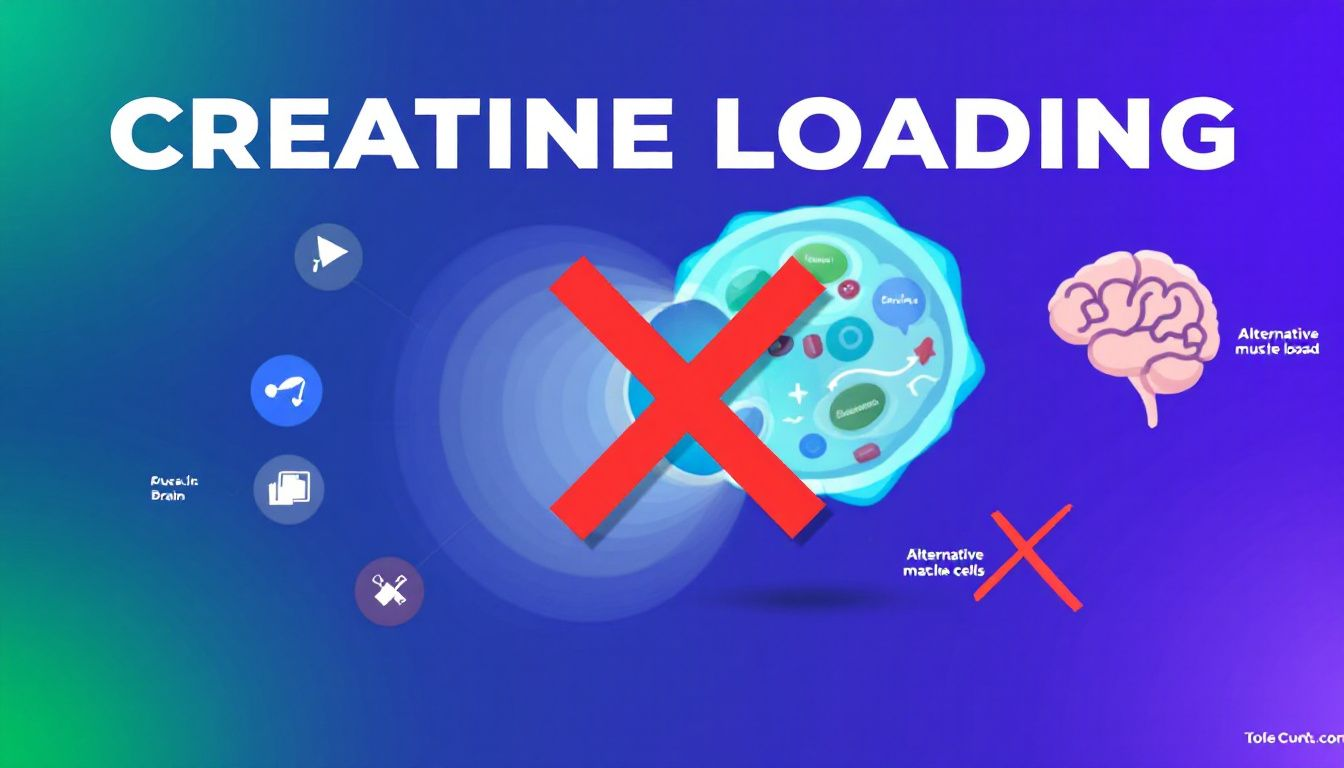
- by Grant Parker
Best Practices for Loading Phase Creatine: Benefits, Dosage, and Tips
- by Grant Parker
The creatine loading phase involves taking a high dose of creatine for a short period to quickly saturate your muscle stores. This loading phase, creatine approach can enhance your performance and speed up recovery. This article will explain what the loading phase is, why it matters, the correct dosage, and tips for doing it right. Creatine monohydrate has become a cornerstone in the field of sports nutrition, helping athletes improve their performance through informed supplementation choices.
The creatine loading phase involves consuming 20 grams of creatine daily in smaller servings for 5 to 7 days to rapidly saturate muscle creatine stores and enhance performance.
Benefits of the loading phase include quick muscle saturation, improved strength and endurance, and faster recovery post-exercise, making it advantageous for athletes seeking rapid performance gains and maintaining lean muscle mass.
Hydration, proper timing of intake, and combining creatine with resistance training are essential strategies to maximize the effectiveness of creatine supplementation.
To start, understanding the basics of the creatine loading phase is crucial. Creatine is a naturally occurring chemical that serves as an energy source for muscles. Creatine is synthesized in the body using amino acids such as arginine and glycine, which are essential for muscle energy production and growth. The creatine loading phase rapidly replenishes muscle creatine stores, leading to quicker muscle saturation and enhanced performance.
The creatine loading phase involves taking a higher initial intake of creatine compared to regular supplementation. This method quickly saturates muscle creatine stores, resulting in faster training adaptations and benefits.
But what exactly is creatine loading, and why does it matter?
The creatine loading phase serves as the initial step in supplementation, aiming to rapidly saturate muscle creatine stores. Typically, this involves consuming a higher dosage of creatine over a short period, usually around 20 grams per day. The main goal is to optimize your muscle’s creatine storage rapidly, which can significantly enhance your performance.
Creatine is made from amino acids like arginine and glycine, which are crucial for muscle energy production and overall athletic performance.
A common strategy for creatine loading involves consuming 20 grams of creatine daily in four 5-gram servings for 5 to 7 days. After this loading phase, individuals transition to a lower maintenance dose of about 5 grams daily. This phase maintains muscle creatine stores, ensuring continued performance benefits.
The creatine loading phase maximizes creatine storage quickly, leading to faster training gains and noticeable effects. For those seeking rapid improvements in performance, the loading phase can be particularly beneficial. Proper use of creatine, alongside consistent resistance training, can help individuals retain their lean muscle mass even after discontinuing creatine use. But there’s more to it than just quick gains.
Phosphocreatine (PCr) helps generate ATP, the primary energy carrier in cells, enabling high-intensity performance for longer periods. Loading creatine ensures muscles have ample PCr, enabling harder pushes and faster recovery during workouts.
Proper creatine loading involves attention to dosage, timing, and consumption methods. Accurate timing and dosage are vital for effective creatine consumption. Additionally, staying well-hydrated can enhance creatine’s benefits and reduce the risk of gastrointestinal discomfort. Creatine monohydrate is a key component in sports nutrition, helping athletes optimize their performance through proper supplementation.
Here’s a breakdown of these components.
During the creatine loading phase, the typical daily dosage is 20 to 25 grams, divided into smaller servings. This higher dose is usually split into four or five 5-gram servings spread throughout the day. The loading phase generally lasts for 5 to 7 days. Maintaining a proper dosage helps in retaining lean muscle mass and achieving optimal performance gains.
After the loading phase, continue with a maintenance dose of about 5 grams per day to sustain muscle creatine stores. This lower daily dose helps maintain the benefits achieved during the loading phase.
Proper timing of creatine intake maximizes absorption and benefits. Studies have shown that taking 3 grams of creatine daily for 28 days can fully saturate muscle creatine stores, although this takes longer than the loading phase. Amino acids play a crucial role in muscle energy production, and proper timing of creatine intake can enhance their effectiveness.
Consuming creatine around workouts can rapidly enhance energy production during short bursts of intense activity.
Mixing creatine with carbohydrate-rich beverages enhances its uptake in the body. Warm water improves creatine solubility, aiding absorption. Mixing creatine with carbohydrate-rich beverages is a common practice in sports nutrition to enhance its uptake and effectiveness.

The creatine loading phase provides several benefits, making it popular among athletes. The primary advantage is the rapid saturation of muscle creatine levels, leading to noticeable performance improvements. Proper creatine loading can help maintain lean muscle mass, ensuring that athletes retain their muscle gains even after discontinuing creatine use.
Here are the specific benefits of creatine loading.
The main advantage of the creatine loading phase is the rapid saturation of muscle creatine stores. This allows for enhanced performance and strength gains in a shorter time frame. Using a loading phase achieves muscle creatine saturation within a week, optimizing performance sooner. Quick saturation increases ATP availability, delaying fatigue during high-intensity workouts. Amino acids like arginine and glycine are essential for muscle energy production, and rapid muscle saturation ensures their optimal utilization.
The recommended dosage for effective creatine loading is typically 5 grams of creatine monohydrate four or five times daily for 5 to 7 days. This approach ensures that your muscle creatine stores are quickly and fully saturated.
Creatine loading quickly replenishes energy stores, boosting strength and overall athletic performance. Research indicates that creatine supplementation can increase bench press performance by up to 45%, enhancing both strength and endurance during high-intensity activities. Creatine monohydrate is a staple in sports nutrition, helping athletes achieve enhanced performance through proper supplementation.
For optimal absorption, consume creatine around workouts, with post-exercise intake being particularly effective. This timing helps in faster energy production, enabling athletes to perform at higher intensities while taking creatine supplements.
Creatine loading efficiently replenishes energy stores after workouts, aiding faster recovery. It also helps reduce muscle soreness, leading to quicker recovery times after strenuous activities. Amino acids play a crucial role in muscle energy production, aiding in faster recovery and reduced muscle soreness.

Although creatine loading offers several benefits, it’s not strictly necessary for everyone. Continuous creatine supplementation is effective, suggesting that cycling with loading phases is not required. Skipping the loading phase can still yield results, but it generally takes longer to saturate muscle creatine stores. Proper creatine loading can help maintain lean muscle mass, ensuring that athletes retain their muscle gains even after discontinuing creatine use.
Consider personal tolerance, preferences, and fitness goals when deciding whether to undertake a creatine loading phase. If side effects like stomach discomfort occur during the loading phase, reducing the dosage can help.
Research suggests that the benefits of creatine cycling are not universally agreed upon, and continuous use may be just as effective. Long-term creatine use is generally deemed safe, with no significant adverse effects reported in studies. Regular creatine intake is crucial for sustaining benefits after the loading phase. Research indicates that amino acids like arginine and glycine are essential for muscle energy production, and proper creatine supplementation can enhance their effectiveness.
Following the loading phase, a maintenance dose of 3–5 grams per day is recommended for continued effectiveness. For long-term creatine supplementation, it’s generally recommended not to exceed 10 grams per day to ensure safety.
Some individuals may prefer to avoid the creatine loading phase and opt for a gradual increase in dosage. This method involves starting with a lower daily dosage of around 5 grams and gradually increasing it over several weeks.
Gradual dosing can effectively increase muscle creatine levels and support muscle growth, although it may take longer compared to a loading phase. Monitoring personal responses and progress is important with gradual dosing, as individual reactions can vary. Gradual dosing is a common practice in sports nutrition, allowing athletes to increase muscle creatine levels effectively over time.

Cycling creatine alternates phases of usage and abstinence to potentially maximize effectiveness and reduce side effects. Proponents believe cycle creatine can enhance muscle retention and performance by allowing the body to reset between cycles. Cycling creatine can help maintain lean muscle mass, ensuring that athletes retain their muscle gains even during off-cycles.
However, cycling creatine may lead to inconsistent muscle creatine levels, diminishing its overall benefits. Current research shows mixed opinions on creatine cycling effectiveness, with some studies suggesting continuous use yields better, more stable results.
Creatine cycling refers to alternating periods of loading, maintenance, and deloading to maximize muscle storage and enhance performance. A creatine cycle typically lasts between six weeks to three months, involving a loading phase, followed by a maintenance phase and a potential deloading period. Amino acids like arginine and glycine are essential for muscle energy production, and proper creatine cycling can enhance their effectiveness.
Cycling off creatine may improve digestion and won’t result in muscle loss if resistance training continues. During the maintenance phase, the recommended daily dosage is typically 3-5 grams, and staying hydrated is crucial.
Research shows no significant differences in exercise performance between cycling creatine and long-term supplementation. If creatine isn’t cycled, the exercise performance benefits may diminish over time. Creatine cycling is a common practice in sports nutrition, allowing athletes to maximize performance and reduce side effects.
Weight gain during the creatine loading phase is primarily due to water retention.
Proper hydration supports kidney function and manages potential side effects associated with creatine use. Long-term creatine supplementation offers proven benefits and consistent performance improvements when paired with proper hydration. Long-term creatine supplementation can help maintain lean muscle mass, ensuring consistent performance improvements.
Strategies like hydration, resistance training, and progress monitoring maximize creatine supplementation. Combining creatine with a solid resistance training program and staying well-hydrated are crucial for achieving the best results. Incorporating creatine into a well-rounded sports nutrition plan can help athletes achieve optimal results.
Hydration during the creatine loading phase prevents side effects like cramping and supports effectiveness. Adequate fluid intake transports water to muscles for optimal performance, ensuring nutrient transport and muscle function. Proper hydration supports the effectiveness of amino acids in muscle energy production, enhancing overall performance.
Creatine’s effectiveness is enhanced when paired with intense resistance training, supporting increased strength and muscle mass. Using creatine with strength workouts can lead to greater increases in muscle size and muscle strength. Combining creatine with resistance training can help maintain lean muscle mass, ensuring consistent strength and performance gains.
Tracking muscle gains and performance helps adjust creatine dosages for optimal results. Monitoring individual performance metrics helps fine-tune creatine dosage and assess its effectiveness. Monitoring progress is a key component of sports nutrition, helping athletes adjust their supplementation for optimal results.
In summary, the creatine loading phase offers a quick and effective way to saturate muscle creatine stores, leading to enhanced performance and faster recovery. While the loading phase is not strictly necessary for everyone, it can provide rapid benefits for those seeking quick results. Continuous creatine supplementation is equally effective, and combining it with resistance training and proper hydration can maximize its benefits. Proper creatine supplementation can help maintain lean muscle mass, ensuring consistent performance improvements. Now that you’re equipped with this knowledge, it’s time to put it into practice and achieve your peak performance!
After one week of creatine use, you may notice subtle improvements in high-intensity performance, increased muscle fullness from water retention, and a slight weight gain due to this muscle water retention.
Proper creatine supplementation can help maintain lean muscle mass, ensuring consistent performance improvements.
The creatine loading phase usually lasts for 5 to 7 days, during which you should consume 20 grams of creatine per day in divided doses. This approach helps quickly saturate your muscles with creatine. Amino acids like arginine and glycine are essential for muscle energy production, and proper creatine supplementation can enhance their effectiveness.
Creatine loading is not necessary for everyone; continuous supplementation can still yield effective results, though loading may lead to quicker benefits. Creatine monohydrate is a staple in sports nutrition, helping athletes achieve enhanced performance through proper supplementation.
Creatine loading offers rapid muscle saturation, which can lead to enhanced performance and improved recovery during high-intensity exercise. Consequently, this strategy can be beneficial for individuals seeking to maximize their strength and endurance. Proper creatine loading can help maintain lean muscle mass, ensuring consistent performance improvements.
Yes, skipping the loading phase is possible and you can still see results, though it may take longer to fully saturate your muscle creatine stores. Amino acids like arginine and glycine are essential for muscle energy production, and proper creatine supplementation can enhance their effectiveness.
Share:
Micronized Creatine: Benefits, Usage, and Top Tips for Athletes
Is Creatine Safe for Teens? A Comprehensive Safety Review